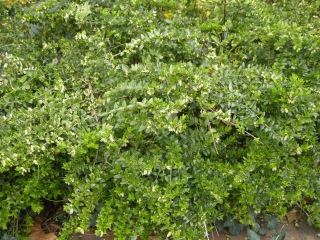Position: Full sun to partial shade
Flowering period: Spring
Soil: Moist, well drained
Eventual Height: 2m
Eventual Spread: 2m
Hardiness: 6b, 7a, 7b, 8a, 8b, 9a, 9b
Family: Caprifoliaceae
Lonicera nitida is a fast growing, compact evergreen shrub. Its dark green, densely packed leaves are opposite, rounded , have entire margins and are up to 16mm long. Its supple stems are layered one top of the other and giving rise to its leaves along its length. Its fragrant flowers are creamy white 6 mm long and are borne in pairs. Its fruit is an inedible bluish purple berry which is about 6mm in diameter.
Lonicera nitida, commonly known as Boxleaf Honeysuckle or Wilson’s Honeysuckle, is native to China. It grows in scrub form along streams at 1200 to 3000 m altitudes. This species has been introduced into cultivation twice in the UK in 1908 and 1939. It was first recorded in the wild in the UK in 1955 and is now widely naturalised in Ireland and England.
The etymological root of the binomial name Lonicera is derived from the name of Adam Lonicer, a German naturalist from the 16th century. Nitida is from the Latin meaning ‘shining’ or ‘bright’.
The landscape architect may find Lonicera nitida useful as a robust evergreen ground cover plant. It also can be forms an effective hedging. It is unattractive to deers and rabbits and is pollution tolerant. Once established this plant is drought tolerant.
Ecologically, Lonicera nitida is attractive to pollinating insects and provides cover for birds.
The Royal Horticultural Society has given the variety Lonicera nitida ‘Baggesens Gold’ their prestigious Award of Garden Merit in 1993.
Lonicera nitida prefers moist, fertile, well-drained soils. It tolerates most pH of soil, including chalky.
Lonicera nitida requires little maintenance. If maintained as a hedge, it should be clipped three times a year to maintain its shape.







In most of UK and Ireland this horrible shrub never flowers. Hence it is useless for pollinators. As a non-native plant, it also has few herbivorous invertebrates feeding from it. Deer and rabbits don’t like it, honey fungus won’t attack it. It easily regrows from cuttings, and as many grow along roadsides.. a disastrous invasive non-native species
lonerica nitida , a true gem in the garden! Your Plant of the Week post beautifully captures its charm. Thanks for the insightful details.